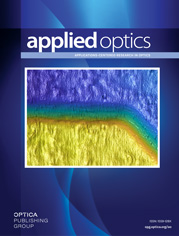Applied Optics Feature Announcement
Laser Applications to Chemical, Security and Environmental Analysis (LACSEA)
Submissions Open: 1 September 2016
Submission Deadline (extended): 15 November 2016
This feature issue of Applied Optics is based on the fifteenth OSA Topical meeting on Laser Application to Chemical, Security, and Environmental Analysis (LACSEA), which will be held 24 July to 28 July 2016 in Heidelberg, Germany. While meeting participants are particularly encouraged to submit their work, this feature issue is open to all contributions. All papers need to present original, previously unpublished work, and will be subject to the normal standards and peer-review process of the journals. To be eligible for publication, any paper from a LACSEA participant needs to add substantial and/or significant new information to the original conference summary. Please see OSA's guidelines on conference papers, found here.
This feature issue is aimed at scientists, engineers, and practitioners interested in understanding the basic principles and diagnostic purposes of a variety of laser-based methods for the quantitative detection and monitoring of essential parameters in probed samples of different origin and aggregate state, i.e., gas, liquid or solid. Its intent is to bring together the development areas of the necessary equipment (lasers, detectors, optics) as well as the methods themselves, and new approaches. The emphasis should be on applications of methods; however, theoretical background on both methods and data evaluation is also welcome if necessary. The methods discussed in this feature issue must meet the requirement of being spectrally selective and provide sufficient detection sensitivity to optimize the performance for the application. There are numerous disciplines which are involved in the successful development of the various diagnostic methods. These include lights sources and optical instrumentation, computational algorithms and spectroscopy; they all contribute to defining the technique and its applications.
Topics of interest include but are not limited to the following areas:
- New technologies in laser sources for optical sensing applications: Continuous wave, pulsed, modulated lasers and their characterization; High repetition rate sources; broadband lasers; Ultrafast lasers; Frequency combs
- Chemical sensing methods: Spectroscopic sensing of gases, aerosols, and particulates; Combustion, plasma and industrial process monitoring; Real-time control; Energy topics; Extension of techniques toward the VUV or THz spectral ranges; Novel spectroscopic science; Extension to multiple points or to volumetric measurements; High-repetition-rate imaging; Sensor miniaturization; medical diagnostic
- Security applications: Remote sensing; Miniaturization, Optical lab-on-chip systems, and silicon photonics; Distributed sensor networks; Biochemical/biophysical applications of laser techniques; Use of new sources offering high power or pulse energy; Nonlinear optical techniques
- Computational, adaptive, and compressive imaging: Wavefront coding and coded aperture systems; Multi- aperture imaging systems; Plenoptic imaging systems and image processing; New imaging system demonstrations; Joint optical-digital system design and optimization; Applications of computational imaging
- Environmental analysis: Atmospheric sensing (concentration, vertical profile, flux, isotope ratio) of gases, solids, and liquids; Atmospheric chemistry (smog chamber study and field campaign observation); Advancements in LIDAR; Extension and improvement of spectroscopic databases; Airborne sensor systems; Ruggedized sensor systems; Propagation of laser beams through scattering media; air pollution and livestock emission
Manuscripts must be prepared according to the usual standards for submission to Applied Optics; see the Information for Contributors in any printed issue or the OSA Style Guide: style guide. Manuscripts must also be uploaded through OSA's electronic submission system: /ao/journal/ao/author.cfm. Please specify that the manuscript is for the Laser Applications to Chemical, Security and Environmental Analysis feature (choose from the feature issue drop-down menu).
Feature Issue Editors
Weidong Chen, Université du Littoral Côte d'Opale, France
Thomas Dreier, University Duisburg-Essen, Germany
Sean P. Kearney, Sandia National Laboratories, USA
Waruna Kulatilaka, Texas A&M University, USA
Thomas Seeger, University Siegen Germany

